Glossary of Pericology
The role of the glossary
This pericological glossary compiles the fundamental terms of the discipline, founded by Jean Bourdin in 2018. It aims to clarify concepts for practical application in anticipating perils, whether biological, socio-cultural, technological or systemic. Each definition is sourced from the pillars of Pericology (observation , analysis , action) and includes examples for contextual adaptation.
The Identity of Pericology
Jean Bourdin
Jean Bourdin is the founder of Pericology, a discipline he created in 2018 to anticipate and prevent systemic perils. He developed this methodical approach by combining rigorous observation, adaptive analysis and targeted action, inspired by the cooperative dynamics of nature. His role has been to structure Pericology around clear principles, identify warning signals, understand their dynamics and intervene before crises, while making it accessible to everyone, from local communities to decision-makers.


Jean Bourdin
Founder / Pericology
Pericology
"Pericology is an applied discipline of anticipation and prevention of systemic perils." Inspired by the cooperative dynamics of nature, it integrates human, technological, and systemic approaches to observe, analyze, and counter threats before they reach a critical threshold. Focused on peripheral anticipation, it translates existing scientific knowledge on collaboration in fauna and flora into practical methodologies, promoting systemic resilience in various contexts (human teams, natural ecosystems, interconnected technological systems). Its slogan, "See before, stop before," embodies proactive vigilance to preserve essential balances in the face of biological, socio-cultural, technological, or systemic perils.

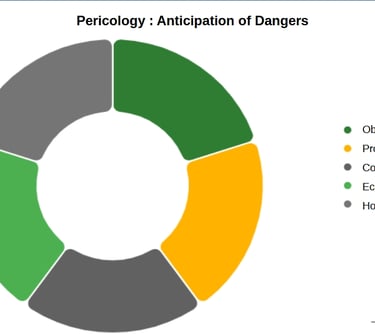
Pericology
Diagram of Pericology
Pericological Example
Context : A rural community relies on a river for agricultural irrigation. Weak signals (subtle declines in flow, observed via local sensors) indicate an imminent risk of drought, which could reach a tipping point (critical water shortage).
Pericological Application : Inspired by the cooperation of ants (redistribution of resources in the event of stress), Pericology mobilizes farmers to observe warning signals (via participatory surveys), analyze dynamics (impact on crops), and take action (distribute water via a bio-inspired quota system).
Etymology
The term "Pericology " derives from two complementary linguistic roots:
Periculum (Latin): means "danger" or "risk", denoting a potential threat to a balance.
Peri (Greek): means "around" or "nearby," suggesting an all-encompassing, peripheral observation of peril dynamics.
Pericological Sources
Pericologist
A "Pericologist" is a practitioner dedicated to the anticipation and prevention of systemic perils. He acts as a proactive sentinel, observing weak and measurable signals, analyzing the dynamics of perils, and implementing concrete actions to counter them before they reach a tipping point. The pericologist relies on bio-inspired approaches, drawn from the cooperative dynamics of nature, and integrates human, technological and systemic perspectives to preserve essential balances in various contexts (human teams, ecosystems, interconnected systems). Unlike a crisis manager, the pericologist focuses on peripheral anticipation, embodying the principle "See first, stop first".


Pericologist
Pericologist Diagram
Pericological Example
Context : In a small coastal town, weak signals indicate a risk of ecological imbalance : an abnormal increase in algae in the harbor waters, coupled with complaints from fishermen about declining catches. These indicators, not yet linked to an obvious crisis, threaten the local ecosystem and the community economy.
Pericological Application : A Pericologist, trained in proactive observation, detects these signals via community monitoring and environmental sensors (Observation). He analyzes the underlying dynamics, identifying a positive loop where industrial discharges amplify algal proliferation (Analyze). Inspired by the self-regulating mechanisms of coral reefs, he proposes immediate action : coordinate local stakeholders (fishermen, authorities, industrialists) to reduce discharges before an ecological tipping point (Act).
Etymology
Periculum (Latin) : "Danger" or "risk", evoking a potential threat to a balance, whether human, environmental or societal.
Peri (Greek) : "Around" or "nearby", implying an all-encompassing and peripheral vigilance to surround the danger without being limited to its surface.
-Logue (from the Greek "lógos") : Meaning "one who studies" or "one who treats/discourses about", as in "ecologist" (study of ecosystems) or "psychologist" (study of the mind).
Pericological Sources
Pericological Vigilance
In Pericology, "Vigilance" refers to a proactive and constant attention paid to the detection of weak and measurable signals of perils, whether biological, socio-cultural, technological or systemic. It embodies the state of peripheral alert allowing us to anticipate risk dynamics before they reach a tipping point. Inspired by natural dynamics, pericological vigilance is based on methodical and contextual observation, combining human intuition and technological tools to identify emerging or invisible perils. It is distinguished by its collective and adaptive nature, mobilizing local actors to preserve essential balances without waiting for obvious signals.
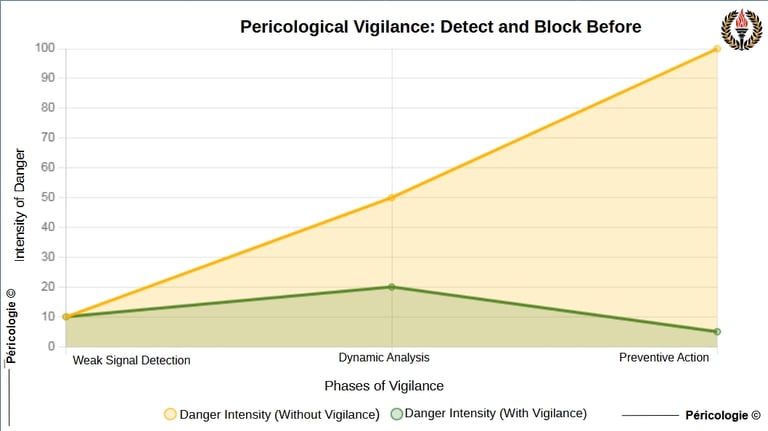

Pericological Vigilance
Diagram of pericological vigilance
Pericological example
Context : In a coastal community at risk of accelerated erosion, weak signals (e.g., subtle increases in water levels measured by sensors) indicate an emerging peril related to soil instability.
Pericological Application : A pericologist applies Vigilance by deploying a network of bio-inspired sensors (mimicking the sensitivity of corals to marine variations) to monitor water levels and dune stability in real time. By detecting abnormal erosion (weak signal), he mobilizes local stakeholders to reinforce natural barriers (e.g., planting stabilizing plants) before the diffuse peril becomes a crisis (coastal collapse). This proactive anticipation illustrates the slogan "See before, steer before."
Etymology
The term vigilance comes from the Latin vigilantia , derived from vigilans (present participle of vigilare), meaning "to be awake, watchful, attentive." The word vigilare is related to vigere ("to be vigorous, to prosper"), suggesting an active energy in observation.
Pericological : From the Latin periculum ("danger, risk") and the Greek peri ("around").
Pericological Sources
Pericological Resilience
In Pericology, "Resilience" refers to the capacity of a system, whether human, biological, technological or systemic, to preserve or restore an essential balance in the face of perils, by anticipating and adapting to disturbances before they reach a tipping point. Unlike classical resilience (e.g., return to the initial state post-crisis, as in ISO 31000 risk management), pericological resilience is proactive, inspired by the collaborative dynamics of nature. It mobilizes bio-inspired tools, such as the self-management observed in animal colonies, to maintain stability in the face of emerging, invisible or diffuse perils.
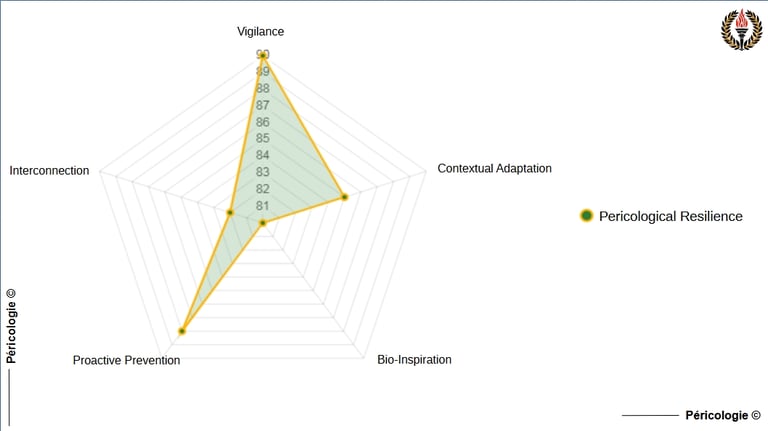

Pericological Resilience
Diagram of pericological resilience
Pericological Example
Context : A small town dependent on a local electricity grid vulnerable to overloads (emerging systemic peril).
Pericological Application : Inspired by ant colonies redistributing resources in the face of a disruption, Pericology proposes a system of intelligent sensors detecting weak overload signals (e.g., consumption peaks). An automatic redistribution of energy to local micro-grids is implemented, preserving the network balance before a critical failure.
Etymology
The term resilience comes from the Latin resilire , a compound of re- ("back") and salire ("to jump"), literally meaning "to bounce back" or "to go back."
Pericological : From the Latin periculum ("danger, risk") and the Greek peri ("around").
Pericological Sources
Pericological Flexibility
In Pericology, "Flexibility" refers to the ability of a system, whether human, biological or technological, to dynamically adjust to evolving contexts and danger signals, while maintaining its functional balance. It is manifested by rapid and contextual adaptation to the dynamics of dangers, without depending on prefabricated solutions. Unlike simple elasticity (return to the initial state), pericological flexibility integrates a proactive reorganization of resources and strategies to anticipate critical thresholds and avoid tipping points.


Pericological Flexibility
Diagram of pericological flexibility
Pericological Example
Context : In a coastal community facing recurrent flooding (systemic peril), traditional solutions (fixed levees) fail in the face of changing climate conditions (varying storm intensity). Weak signals (increasing micro-floods) indicate a potential tipping point towards major floods.
Pericological Application : Flexibility, as a contextual adjustment capacity, guides the pericological observer to detect local variations (e.g.: rising tides via sensors). The analyzer models the dynamics (positive loop : erosion amplifying the risk). The action consists of deploying bio-inspired modular barriers (inspired by mangroves, which adapt to flows), adjusted in real time according to the intensity of the tides.
Etymology
The term flexibility derives from the Latin flexibilitas , from flexibilis (“foldable, adaptable”), itself formed from the verb flectere (“to bend, to curve”).
Pericological : From the Latin periculum ("danger, risk") and the Greek peri ("around").
Pericological Sources
https://www.clionautes.org/risques-quotidien-vulnerabilite-resilience-adaptation.html
https://shs.cairn.info/revue-questions-de-management-2023-5-page-148?lang=fr
https://www.afd.fr/fr/actualites/anticiper-subir-adaptation-catastrophes-naturelles-guadeloupe
https://shs.cairn.info/revue-francaise-de-gestion-2006-3-page-35?lang=fr
https://anticiper.org/resilience/capacite-d-adaptation-facteur-resilience-important.php
The Foundations of Pericology
Sentinel of Perils
The "Sentinel of Perils" designates, in Pericology, the fundamental role of proactive and systemic monitoring of peril dynamics, whether biological, socio-cultural, technological or systemic. This concept embodies a peripheral vigilance, inspired by the cooperative dynamics of nature, which consists of detecting weak or measurable signals before they reach a tipping point. The Sentinel acts as a methodical observer, analyzing the underlying dynamics to propose preventive actions, in accordance with the slogan "See before, stop before". It does not react after the fact like traditional approaches, but anticipates to preserve essential balances.
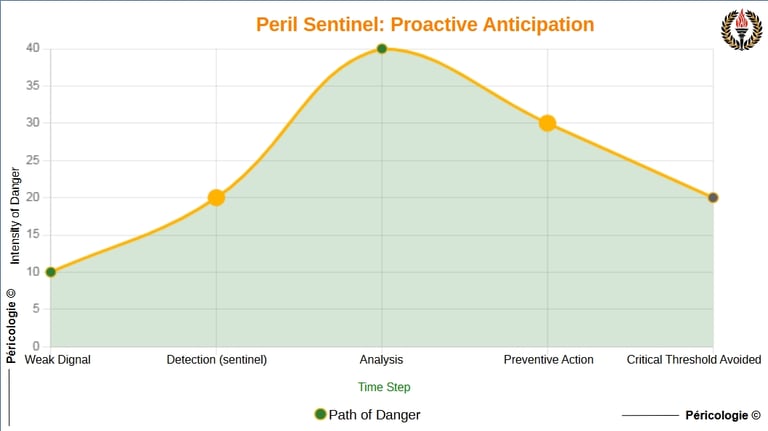

Sentinel of Perils
Diagram of the Sentinel of Perils
Pericological Example
Context : In a rural community dependent on a river for irrigation, weak signals (abnormal flow variation) indicate an imminent risk of drought, amplified by intensive agricultural practices (positive loop). Traditional approaches would wait for a visible crisis (water shortage) to react, but Pericology acts upstream.
Pericological Application : As a Sentinel of Perils , a local pericologist observes measurable signals (flow, soil moisture) and draws inspiration from ecosystems (e.g., water redistribution in mangroves). He mobilizes farmers to adjust irrigation via micro-canals, preventing the tipping point (irreversible drought).
Etymology
Sentinel : From the Latin sentinella (16th century, via Italian), derived from sentire (“to feel, to perceive”), evoking an entity which perceives and alerts to imminent danger.
Perils : From the Latin periculum (“danger, risk”), central root of Pericology, highlighting a systemic threat to an equilibrium.
Pericological Sources
Peripheral Anticipation
"Peripheral Anticipation" is the founding approach of Pericology, consisting of identifying, observing and analyzing early signals of perils in a given environment, before they escalate or transform into a crisis. Inspired by the cooperative dynamics of nature, it mobilizes a comprehensive and proactive observation of systemic dynamics, whether human, biological or technological. Unlike reactive crisis management, it acts upstream to prevent critical thresholds, relying on weak and measurable signals, without presupposing perfect cooperation.


Peripheral Anticipation
Diagram of Peripheral Anticipation
Pericological Example
Context : In a coastal city, a local community relies on a mangrove ecosystem to protect its shores from erosion and storms. Historical data shows early signs of degradation (e.g., increased mangrove mortality due to saline pollution), but traditional indicators (e.g., water levels) do not yet signal an imminent crisis. Decision-makers risk ignoring these weak signals , amplifying a systemic peril (ecological collapse and flooding).
Pericological Application : By applying Peripheral Anticipation , inspired by bio-inspired dynamics (e.g., coral colonies detecting environmental stress via diffuse signals), Pericology mobilizes local sensors (e.g., salinity probes) and community observations to identify warning signals (e.g., anomalies in mangrove growth). A rapid analysis (via the Pericological Analyzer) identifies a potential critical threshold : saline accumulation threatens anecological tipping point. Proactive action (e.g., installation of biological filters inspired by ecosystem regulation mechanisms) is implemented to reduce salinity, blocking the peril before it reaches a crisis.
Etymology
Peripheral : Derived from the Greek péri ("around", "nearby") and phérō ("to carry"), implying all-encompassing vigilance around threatened systems.
Anticipation : From the Latin anticipare (“to act before”), emphasizing preventive action in the face of dangers.
Pericological Sources
https://lettres.tice.ac-orleans-tours.fr/php5/coin_eleve/etymon/geo/peripherie.htm
https://www.academia.edu/143727541/La_D%C3%A9sinformation_Amplifi%C3%A9e_par_l_IA?source=swp_share
https://www.seuil.com/ouvrage/la-methode-tome-1-edgar-morin/9782020042678
https://www.sciencedirect.com/science/article/pii/S0148296320301234
Bio-Inspired Prevention
"Bio-Inspired Prevention" is a central methodological approach of Pericology, which adapts the cooperative and adaptive dynamics observed in fauna and flora to anticipate and counter perils, mainly biological, before they reach critical thresholds. It relies on natural mechanisms of collaboration, self-management and feedback (such as negative stabilizing loops in ecosystems) to design intuitive, accessible and scientifically validated solutions. Unlike technocentric approaches, it favors simple strategies, not presupposing perfect human cooperation, but adapting to the practical realities of interconnected human, natural or technological contexts.
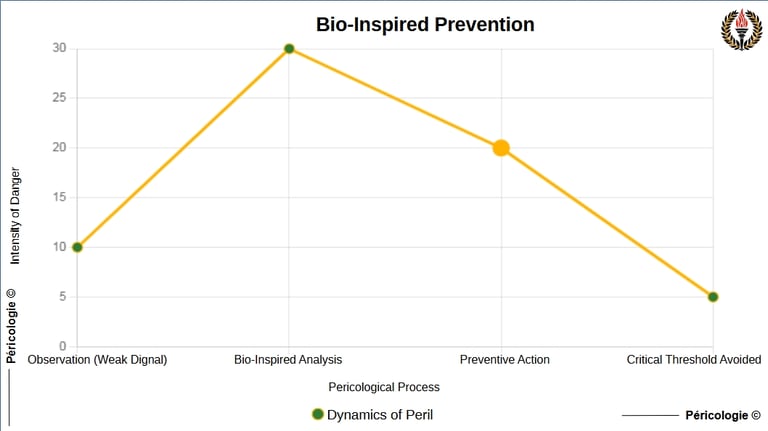

Bio-Inspired Prevention
Diagram of bio-inspired prevention
Pericological Example
Background : A project team in a technology company faces an emerging peril : work overload threatening a tipping point (collective burnout). Weak signals include recurring delays and degraded communication, detected via measurable indicators (e.g., increased error rate).
Pericology Application : Inspired by the cooperation of fish schools (e.g., redistribution of roles in the face of a predator), bio-inspired prevention offers a dynamic reorganization of tasks. The team adjusts its priorities in real time, redistributing workloads via collaborative micro-decisions, without waiting for centralized management.
Etymology
The term " Prevention " derives from the Latin praeventio ("action of anticipating, anticipating"), implying proactive action in the face of danger.
" Bio-Inspired " combines bio (from the Greek bios , "life") and inspired (from the Latin inspirare , "to blow into, to animate"), emphasizing an approach drawn from living processes.
Pericological Sources
Proactive Prevention
"Proactive Prevention", within the framework of Pericology, refers to all methodical and anticipatory actions aimed at countering systemic perils before they reach a critical threshold, such as a tipping point. Anchored in the fundamental pillars of the discipline (observation, prevention, contextual adaptation), it relies on rigorous detection of warning signals, weak or measurable, to design interventions adapted to local and evolving dynamics. Inspired by bio-inspired regulatory mechanisms, proactive prevention favors practical and contextual solutions, avoiding prefabricated approaches. It mobilizes local actors to preserve human, environmental or technological balances, by anticipating emerging, invisible or diffuse perils.
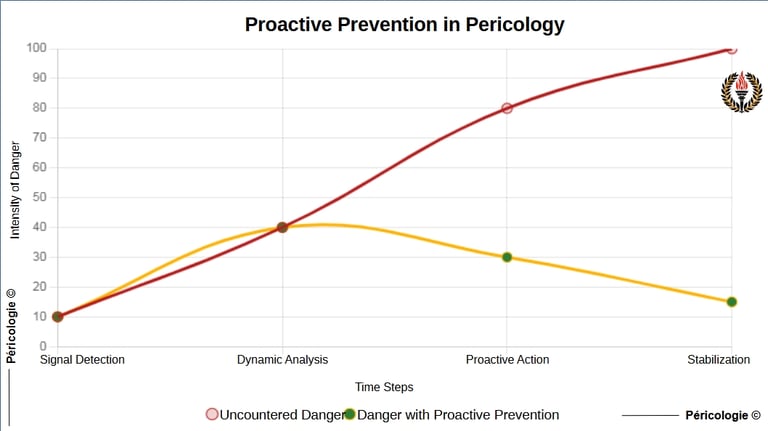

Proactive Prevention
Proactive Prevention Diagram
Pericological Example
Context : In an interconnected food production plant, a weak signal (abnormal temperature fluctuation in a warehouse) is detected via IoT sensors. This signal, which is not critical in isolation, could trigger a chain reaction (e.g., product spoilage, logistics disruption), a systemic hazard amplified by the interconnectedness of the systems.
Pericological Application : Proactive Prevention, a pillar of Pericology, uses a bio-inspired approach (e.g., thermal regulation of beehives) to analyze the signal and act before the tipping point. Methodical action is implemented : automatic adjustment of cooling parameters and alert to local teams for inspection.
Etymology
Prevention : From the Latin praeventionem (from prae, "before", and venire, "to come"), literally meaning "to act before something happens".
Proactive : From the Latin prefix pro ("forward") and actio ("action"), implying voluntary and anticipated initiative, as opposed to passive reaction.
Pericological Sources
https://www.zengrc.com/blog/proactive-vs-reactive-risk-management-strategies/
https://www.sciencedirect.com/science/article/abs/pii/S0005796721000334
https://www.sciencedirect.com/topics/engineering/proactive-approach
https://www.health.org.uk/publications/proactive-approaches-to-safety-management
https://www.metricstream.com/insights/proactive-risk-management-approach.htms
Contextual Adaptation
"Contextual Adaptation", a fundamental pillar of Pericology, refers to the ability to adjust hazard prevention strategies and actions to the evolving specificities of local contexts, whether human, biological or technological. It involves methodical responsiveness to the changing dynamics of interconnected systems, drawing on rigorous observations and local data to design tailor-made solutions. Unlike standardized or prefabricated approaches, contextual adaptation mobilizes field knowledge and bio-inspired dynamics to anticipate and counter hazards before their tipping point.

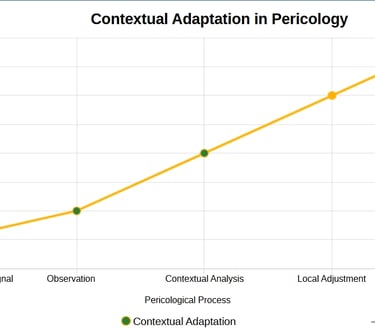
Contextual Adaptation
Diagram of contextual adaptation
Pericological Example
Context : In a small farming community facing an emerging drought (systemic peril), weak signals (declining groundwater levels) are detected via local sensors. Local dynamics (clay soil, traditional irrigation practices) and interdependencies (farmers, river ecosystem) require an adapted response, avoiding generic solutions such as expensive water imports.
Periological Application : Inspired by the water regulation of mangroves (natural negative loop), Contextual Adaptation leads to a targeted redistribution of water resources via community micro-canals, adjusted to the clay soil, and to training farmers in drip irrigation techniques. This solution, co-constructed with local stakeholders, prevents the depletion of reserves before the tipping point (irreversible drought), while strengthening collective resilience.
Etymology
Adaptation : From the Latin adaptare ("to adjust, to conform"), formed from ad- ("towards") and aptare ("to make suitable, to adjust").
Contextual : From the Latin contextus ("fabric, connection"), derived from contexere ("to weave together").
Pericological Sources
The Operational Principles of Pericology
Operational Principles
The "Operational Principles" constitute the fundamental methodological framework of Pericology, structuring the approach to anticipating and preventing systemic perils in three interconnected steps : Observe, Analyze, and Act. These principles guide the pericologist in detecting weak or measurable signals (Observation), assessing the dynamics and critical thresholds of perils (Analysis), and implementing targeted actions to neutralize them before they reach a tipping point (Action). Inspired by the collaborative dynamics of nature, such as the vigilance and response systems of ecosystems, they promote a proactive, adaptable, and contextual approach, without presupposing perfect human cooperation. Unlike reactive crisis management frameworks, these principles are oriented toward peripheral anticipation, aiming to "see first, stop first."
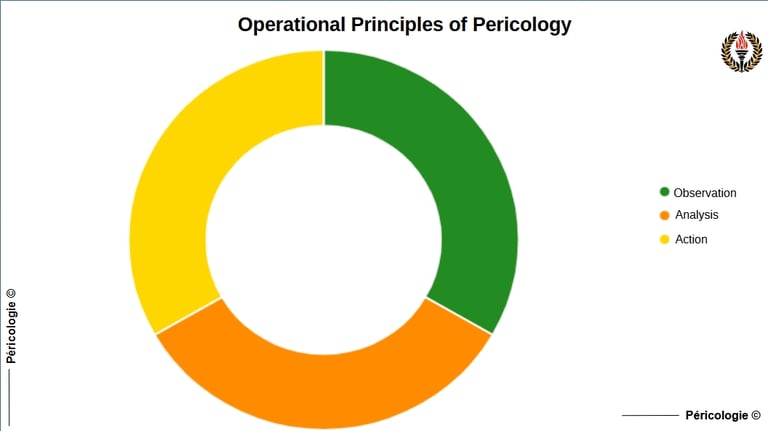

Operational Principles
Diagram of operational principles
Pericological Example
Context : In a regional seaport, recurring delays in the supply chain (unloading containers) threaten to cause major congestion, risking a tipping point (stoppage of port operations). This systemic peril is amplified by weak signals (e.g., micro-failures in automated cranes) and interdependencies (reliance on digital flows for coordination).
Pericological Application : Observer : Pericologists detect weak signals via IoT sensors signaling abnormal slowdowns in cranes (e.g., 10% drop in hourly efficiency). Inspired by fish school vigilance systems, they monitor flows in real time. Analyze : They contrast these signals with historical data and model a positive loop (delays amplifying congestion). Act : A bio-inspired preventive actionis implemented.
Etymology
The term "Principles" derives from the Latin principium ("beginning", "foundation"), designating a structuring basis for action.
"Operational" comes from the Latin operatio ("action", "work"), emphasizing concrete implementation.
Pericological Sources
Observation
In Pericology, "Observation" refers to the methodical and systematic act of detecting weak or measurable warning signals announcing systemic perils in human, biological or technological contexts. The first fundamental pillar of the discipline, it consists of actively scrutinizing the evolutionary dynamics of systems to identify early signs of imbalance, before they reach a tipping point. This observation is inspired by the cooperative dynamics of nature, where species such as meerkats or schools of fish collectively detect threats. Unlike passive surveillance, pericological observation is proactive, anchored in peripheral vigilance, and aims to provide raw data that can be used for analysis and action.
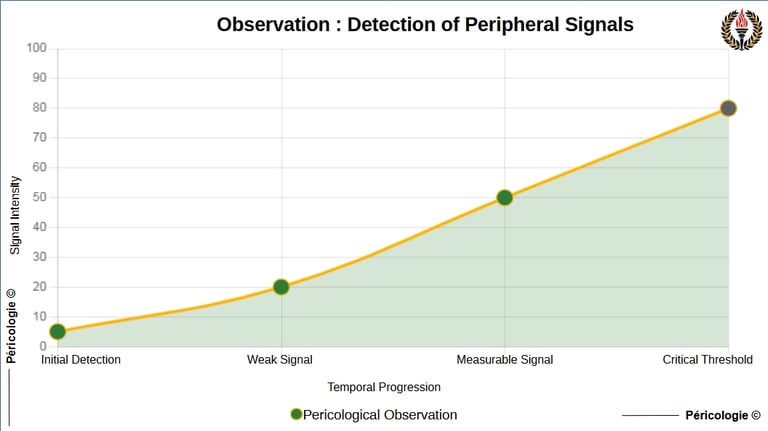

Observation
Observation diagram
Pericological Example
Context : In an interconnected automated factory, micro-variations in machine energy consumption signal a risk of imminent overload, which could lead to systemic failure.
Pericological Application : A pericologist, playing the role of Observer, deploys IoT sensors to monitor energy fluctuations (measurable signals) in real time. Inspired by schools of fish that detect disturbances via coordinated movements, he calibrates the sensors to spot subtle anomalies (weak signals). This early observation makes it possible to identify a risk of overload before it reaches a critical threshold, triggering analysis and preventive action (e.g., load redistribution).
Etymology
The term "observation" comes from the Latin observatio (action of observing, attention), derived from observare (to monitor, guard, examine), formed from ob- (towards, in the direction of) and servare (to keep, protect, observe).
Pericological Sources
Analyze
In the context of Pericology, "Analyze" refers to the methodological step of assessing the importance, underlying causes and dynamics of identified perils, in order to understand their impact potential and critical thresholds. This phase, the second pillar of the pericological methodology, is based on a rigorous and systemic approach to contrast weak and measurable signals detected during observation. Pericological analysis is not limited to a static description, but seeks to model dynamic interactions to anticipate the evolution of perils before they reach a tipping point. It is inspired by the cooperative dynamics of nature, where threat assessment is based on contextual and adaptive understanding, without presupposing prefabricated solutions.

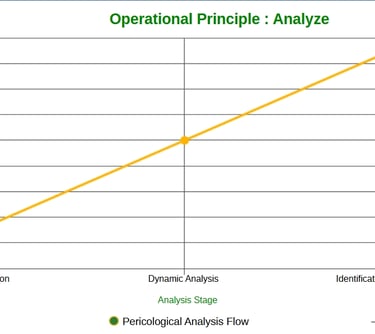
Analyze
Diagram of the analysis
Pericological Example
Context : In an interconnected logistics network (e.g., industrial supply chain), a weak signal is detected by the Observer : a local overload at a key node (e.g., delivery delay due to a minor breakdown). This systemic context, where interdependencies amplify dysfunctions (positive loop), requires analysis to avoid a tipping point towards a generalized crisis (e.g., chain paralysis).
Pericological Application : Applied via Holopraxy (sub-branch Cyclosynpraxy for systemic perils), this analysis leads directly to "Act " : proposal of a bio-inspired feedback (e.g.: automatic redistribution of flows, mimicking the self-management of a river ecosystem).
Etymology
The word analyze comes from French, derived from the term analysis, from the medieval Latin analysis, itself borrowed from the ancient Greek ἀνάλυσις (análisis), meaning "dissolution" or "decomposition". Compound of ἀνά (aná , "up", "through") and λύσις (lýsis , "action of untying, resolving"), it evokes the idea of breaking down a whole into its parts to understand its structure and relationships.
Pericological Sources
Act
In the context of Pericology, "Acting" refers to the final operational step in the methodical process aimed at countering systemic perils before they reach a critical threshold or tipping point. It involves implementing concrete, targeted and context-appropriate actions, based on the observation of warning signals and the analysis of peril dynamics. These actions are inspired by the cooperative dynamics of nature to preserve human, biological or technological balances. Acting is not an improvised reaction, but a strategic, rigorous and proactive intervention.
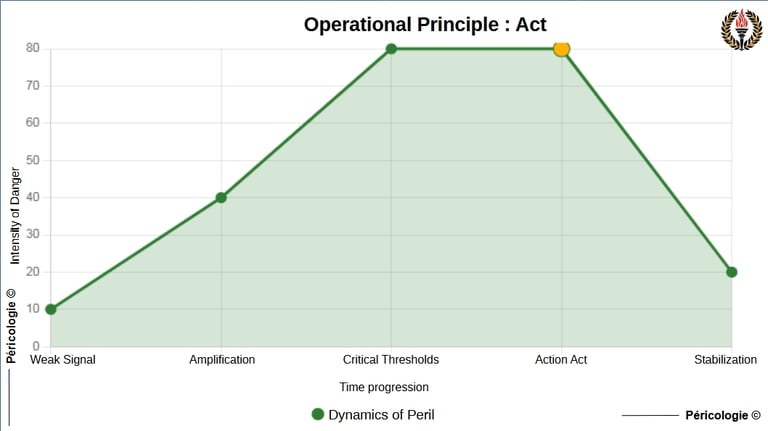

Act
Action diagram
Pericological Example
Context : In an interconnected factory, a weak signal (abnormal fluctuation in energy consumption) is detected by sensors, indicating a risk of overload that could lead to a systemic failure (tipping point). Observation (via the Observer) and analysis (via the Analyzer) reveal a positive loop dynamic amplifying the danger.
Pericological Application : Inspired by bio-inspired regulation (e.g.: redistribution of resources in an ant colony), the "Act" principle leads to immediate action : dynamically adjusting the distribution of the energy load via an automated algorithm, reducing the overload before it reaches the critical threshold.
Etymology
The term "agir" comes from the Latin agere , meaning "to do," "to act," or "to lead." This verb, formed from the Indo-European root ag- ("to lead," "to push"), implies a dynamic of intentional and directed movement.
Pericological Sources
The Methodology of Pericology
Pericological Methodology
The "Pericological Methodology" refers to the structured and systematic set of operational steps for anticipating, analyzing and preventing systemic perils in human, biological or technological contexts. Anchored in the three fundamental pillars of Pericology, observation, proactive prevention and contextual adaptation, it is broken down into three key phases : Explore, Analyze and Decode. These steps translate bio-inspired cooperative dynamics (from fauna and flora) into practical actions to detect warning signals, assess their severity and act before the perils reach a tipping point. Unlike reactive crisis management methodologies, it favors peripheral, methodical and contextual anticipation, without presupposing perfect cooperation, for systemic resilience.
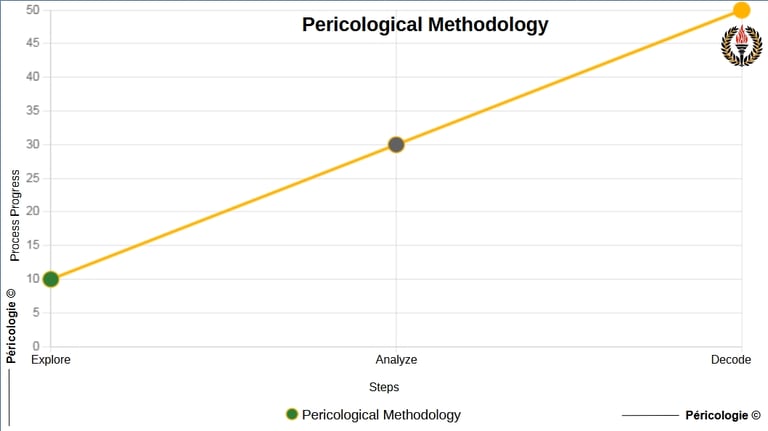

Pericological Methodology
Diagram of the pericological methodology
Pericological Example
Context : In an interconnected logistics network (e.g., industrial supply chain in 2025), a systemic peril emerges from increased dependence on vulnerable digital suppliers, amplified by weak signals such as network micro-interruptions (verified via global risk monitoring 2025). This context differs from classic crises (e.g., pandemic) by its initial invisibility, requiring non-ideological anticipation to preserve operational balance.
Periological Application : Explore : Monitor data flows to detect cyclical anomalies (inspired by ecosystem regulations, such as predator-prey cycles), identifying a 15% increase in network latencies as an early signal. Analyze : Assess the impact via an interdependency matrix (e.g., 40% of suppliers affected by a central hub), contrasting causes (software vulnerabilities) without external assumptions. Decode : Decode the critical threshold (e.g., latency > 200ms triggers a positive loop of cascading failures), proposing an action : decentralized redundancy via bio-inspired microgrids (like the interconnected roots of forests).
Etymology
Methodology : From the Greek methodos ("pursuit of a path", from meta : "towards" and hodos : "path") and logos ("discourse, study").
Pericological : From the Latin periculum ("danger, risk") and the Greek peri ("around").
Pericological Sources
Explore
In the context of Pericology, "Exploring" refers to the initial step of the methodology aimed at systematically and proactively studying the evolving dynamics of perils. This exploration consists of detecting early signals, whether weak or measurable, in interconnected systems (human, biological, technological) to identify potential causes, drivers and trajectories of dangers. Unlike simple passive observation, exploring involves active investigation, bio-inspired by the cooperative dynamics of nature, to map emerging, invisible or diffuse perils before they reach critical thresholds.


Explore
Explorer diagram
Pericological Example
Context : In an interconnected automated factory, irregular fluctuations in machine energy consumption are detected, but not yet critical. These weak signals could indicate an emerging systemic peril (e.g., cascading failure of the electrical grid). The context is marked by a complex interconnection between technological and human systems (operators monitoring machines), requiring proactive anticipation.
Pericological Application : The "Explore" stage consists of studying the evolutionary dynamics of this potential peril. Inspired by natural ecosystems (e.g., observing migratory flows in a school of fish to detect disturbances), the pericologist collects raw data via IoT sensors (energy consumption, frequency of breakdowns). He maps the interactions between machines and operators to identify warning signals (e.g., localized overheating).
Etymology
The term explorer comes from the Latin explorare , formed from ex- ("outside", "beyond") and plorare ("to shout" or "to examine", linked to the idea of sound or visual investigation). Historically, explorare referred to the act of reconnaissance of a territory or danger, often by military scouts.
Pericological Sources
Analyze
In Pericology, "Analyze" refers to the methodological step of assessing the importance, underlying causes and dynamics of identified hazards, in order to understand their potential for amplification or regulation. This analysis is based on a systemic approach, crossing weak signals, measurable signals and local contexts to anticipate critical thresholds (tipping points). Unlike a reactive analysis, it is proactive, bio-inspired (drawing on the cooperative dynamics of nature) and oriented towards immediate action to block hazards before they magnify.

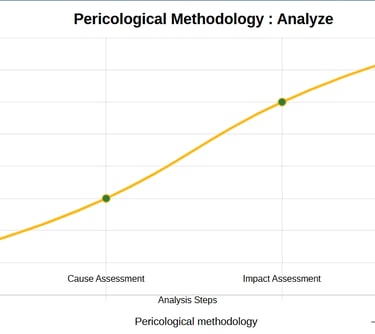
Analyze
Analysis diagram
Pericological Example
Context : In an interconnected logistics network (e.g., industrial supply chain), a weak signal is detected via "Explorer" : an abnormal fluctuation in delivery times due to latent geopolitical tensions, potentially amplified by technological dependencies (e.g., vulnerable tracking software). This systemic peril remains diffuse and invisible without analysis, risking a tipping point towards a global breakdown.
Pericological Application : Applying "Analyze" consists of evaluating the importance of this fluctuation (e.g.: potential impact on 40% of flows via a bio-inspired interdependency matrix, like trophic networks in ecology where a local disturbance cascades). We contrast the causes (geopolitical vs. technological) and measure the impact (e.g.: amplification via positive loop if ignored, leading to losses estimated at 15% of productivity).
Etymology
The term analyze comes from the Greek analusis (ἀνάλυσις), formed from ana- ("up", "through") and lusis ("dissolution", "separation"). It literally means "to break down into elements" or "to examine in detail".
Pericological Sources
Decode
In the context of Pericology, "Decoding" refers to the methodological step of interpreting and understanding the level of severity of hazards as well as their critical thresholds, based on weak, measurable or precursor signals identified during the exploration and analysis phases. This action aims to translate the complex dynamics of hazards (biological, socio-cultural, technological or systemic) into usable information to anticipate and prevent their transformation into crises. Decoding is not limited to passive analysis : it is an active, rigorous and contextual approach, which identifies potential tipping points and proposes hypotheses for evolution to guide immediate preventive actions.
Key characteristics : Role : Pivot between analysis (assessment of causes) and action (implementation of solutions), anchored in the methodological pillar. Objective : Transform raw data or signals into strategic understanding, promoting proactive prevention. Pericological specificity : Unlike simple data analysis (e.g.: classic risk management), decode integrates a bio-inspired and interdisciplinary vision, anticipating systemic dynamics.
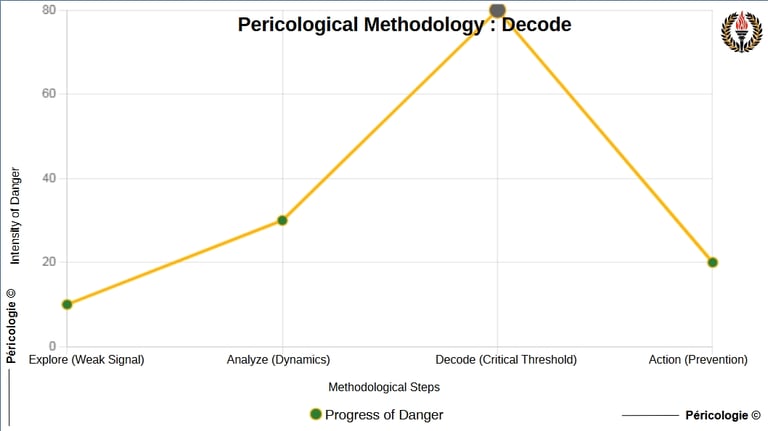

Decode
Decode diagram
Pericological Example
Context : In September 2025, an emerging systemic peril manifests itself through growing cyber threats, such as ransomware attacks targeting critical infrastructure (e.g., utilities, hospitals). Verified via the Canadian Centre for Cyber Security's 2025-2026 National Cyber Threat Assessment, which notes financial losses and operational disruptions, with cases such as the exploitation of MOVEit vulnerabilities in 2023 (extrapolated to 2025), cross-referenced with French reports on systemic risks in insurance (climate, cyber, pandemic). This peril is interconnected : a local attack can cascade into a global crisis, amplified by emerging states using commercial ecosystems for covert cyber operations.
Pericological Application : In an IT security team (human-technological context, aligned with Holopraxy, after having explored the dynamics (e.g.: increase in intrusion attempts) and analyzed their impact (e.g.: vulnerabilities in file transfer systems), "Decode" evaluates the severity : critical threshold identified at 20% network overload (tipping point towards cascading failure, inspired by negative loops of ecosystem regulation such as redistribution in a coral reef).
Etymology
The term decode comes from the French dé- (a prefix indicating a reverse action or extraction) and coder (from the Latin codex , meaning "register" or "writing"). Originally, codex referred to a set of tablets or organized texts, implying a structure to be deciphered.
Pericological Sources
Key Concepts of Pericology
Key Pericological Concept
The "Key Concepts " designate the fundamental mechanisms that govern the dynamics of perils within Pericology, to anticipate and prevent systemic crises. These concepts, inspired by the cooperative dynamics of nature (fauna and flora), make it possible to model, understand and counter perils before they reach a critical threshold. They include the positive loop (self-reinforcing amplification of perils, e.g., viral propagation in an ecosystem or social panic), the negative loop (regulatory mechanisms stabilizing a system, e.g., body thermal regulation), and the tipping point. Anchored in scientific rigor, these concepts translate biological observations into practical tools for human, technological or systemic contexts, promoting peripheral anticipation.
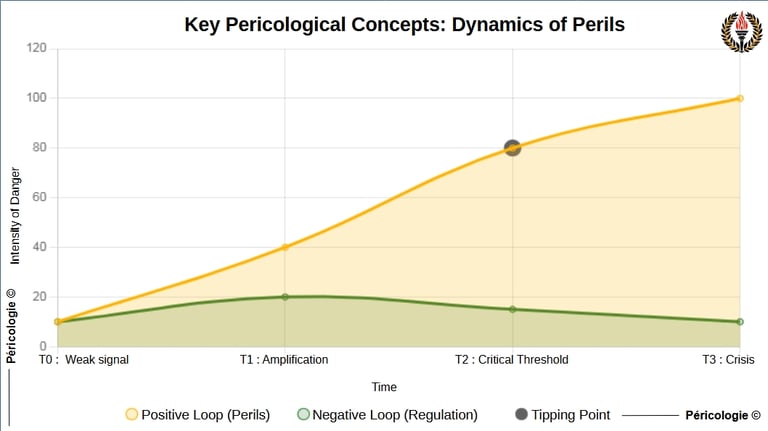

Key Pericological Concept
Diagram of the key pericological concept
Pericological Example
Context : In a coastal city, dune erosion due to frequent storms threatens local habitats and tourism infrastructure. Weak signals (e.g., decrease in stabilizing vegetation) are detected through pericological observation, but ignored by traditional coastal management approaches.
Pericological Application : Positive loop : Erosion accelerates sand loss, amplifying the vulnerability of dunes to storms (self-reinforcing). Negative loop : Inspired by ecosystems (e.g., plant roots fixing sand), Pericology suggests planting resistant plants to stabilize the dunes, regulating the danger. Tipping point : Identify the threshold where erosion becomes irreversible (e.g., 50% of dunes lost). Preventive action (planting before this threshold) blocks the crisis.
Etymology
The term "Key Concepts" comes from the Latin conceptus ("formed idea, thought") and the English key (from the Old English cǣg , "key"), meaning pivotal notions unlocking the understanding of complex dynamics.
Pericological : From the Latin periculum ("danger, risk") and the Greek peri ("around").
Pericological Sources
The Negative Pericological Loop
In Pericology, the "Pericological Negative Loop" refers to a systemic regulatory mechanism that mitigates or stabilizes a hazard before it reaches a critical threshold, drawing inspiration from the natural feedback dynamics observed in fauna and flora. This process counterbalances amplifying dynamics (positive loops) by mobilizing corrective actions based on the observation of weak or measurable signals. Unlike reactive approaches, the pericological negative loop acts proactively to prevent the escalation of biological, socio-cultural, technological or systemic hazards. It relies on collective coordination and self-management, adapted to local contexts, to maintain a systemic balance.
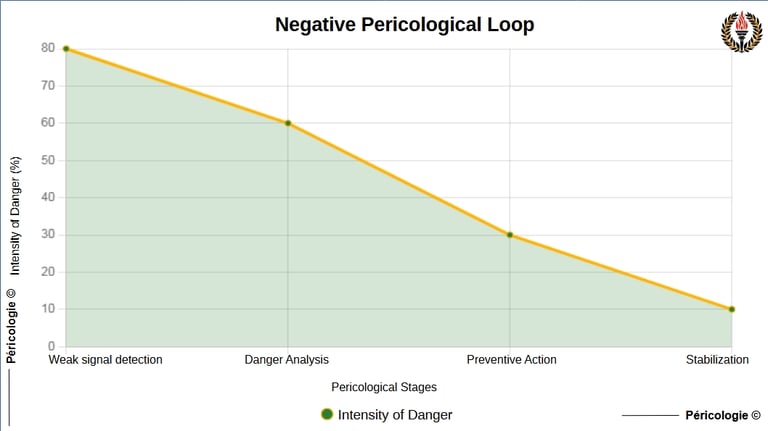

Negative Pericological Loop
Diagram of the Pericological Negative Loop
Pericological Example
Context : In a small farming community facing increasing soil erosion (emerging peril), farmers are observing declining yields (weak signal). Without intervention, this dynamic could reach a tipping point, rendering the land uncultivable.
Pericological Application : Pericologyapplies a negative loop inspired by forest ecosystems, where the plant cover stabilizes the soil. Farmers, through observation (pericologist as observer), identify the weak signal and analyze the cause (erosion by overgrazing). They act by planting plant hedges (preventive action), which reduce erosion and regulate the danger, preserving the balance of the agricultural system.
Etymology
Loop : From the old French " boucle " (12th century), from the Latin buccula ("small mouth" or "ring"), designating a closed cycle or feedback.
Negative : From the Latin negativus ("which denies" or "opposed"), indicating an action of attenuation or counterbalancing in the face of an amplifying dynamic.
Pericological : Derived from Pericology (Latin periculum , "danger", and Greek peri , "around"), emphasizing the peripheral anticipation of perils.
Pericological Sources
The Positive Pericological Loop
In Pericology, a "Pericological Positive Loop" refers to a self-reinforcing amplification mechanism by which a systemic peril, whether biological, human, technological or mixed, rapidly intensifies through cascading interactions. This concept, inspired by natural dynamics (e.g., propagation of a forest fire by wind reinforcing heat), identifies the thresholds where a weak signal becomes critical, risking a tipping point. Pericology uses it to detect these dynamics early and propose interventions before irreversible escalation. Unlike cybernetic positive loops, it is contextualized in peripheral anticipation, integrating bio-inspired and practical solutions.


Positive Pericological Loop
Diagram of the Positive Pericological Loop
Pericological Example
Context : In an interconnected technological system such as an IoT sensor network in an urban environment (e.g., logistics flow monitoring), an emerging hazard such as a minor overload (weak signal : 5% increased latency) is detected via peri-ecological observation. Without intervention, this overload self-amplifies : neighboring sensors compensate, increasing the overall load, creating a positive loop where the initial failure propagates cumulative errors (e.g., 20% then 50% latency in 24 hours), threatening the systemic balance (tipping point : cascading failure affecting transport and safety).
Pericological Application : Applying Ecosynpraxia, model the loop via natural feedback (e.g.: swarm of bees redistributing tasks to avoid overload). Proactive action : Deploy an analyzer to contrast dynamics (evaluate impact : critical threshold at 30% latency), then act by redistributing tasks via self-managed algorithms (e.g.: 10% reduction of load on adjacent sensors).
Etymology
Loop : From Old French " boucle " (13th century), derived from the Latin buccula ("small mouth" or "ring"), designating a cyclical or repetitive structure.
Positive : From the Latin positivus (“posited, affirmed”), indicating an amplification or reinforcement in a system.
Pericological : Derived from periculum (Latin, "danger") and péri (Greek, "around"), emphasizing the peripheral anticipation of dangerous dynamics .
Pericological Sources
The Pericological Tipping Point
The "Pericological Tipping Point" refers to the critical threshold at which a peril, whether biological, socio-cultural, technological or systemic, reaches a level of intensity such that it becomes an irreversible or difficult to control crisis. In Pericology, this concept identifies the moment at which peril dynamics (amplified by positive loops or mitigated by negative loops) exceed a point of equilibrium, leading to a systemic tipping point. This is a key indicator for proactive anticipation, allowing action to be taken before critical thresholds are crossed.
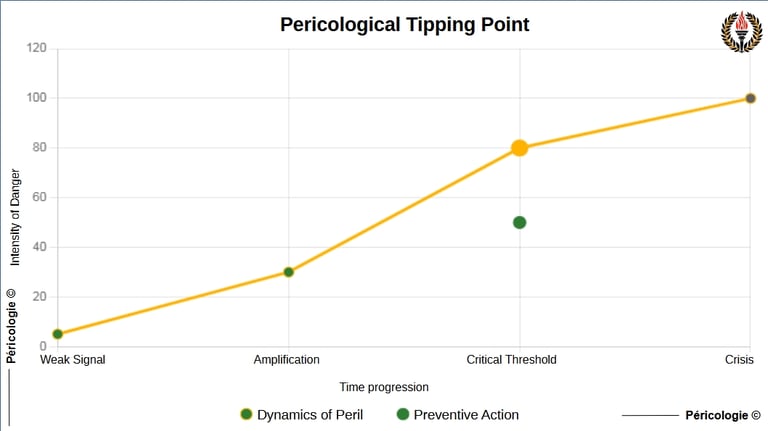

Pericological Tipping Point
Diagram of the pericological tipping point
Pericological Example
Context : A small project team in a technology company is facing work overload due to tight deadlines. Weak signals (decreased communication, increased fatigue) are detected through daily meetings but not addressed.
Pericological Application : Inspired by bio-inspired regulatory mechanisms (e.g., redistribution of resources in an ant colony), Pericology aims to identify the tipping point (risk of collective burnout threatening the project). The observer identifies the signals (e.g., frequent errors), the analyzer evaluates the threshold (e.g., 80% of members overloaded), and the action consists of reallocating tasks or integrating a structured break, blocking the danger before the crisis.
Etymology
The term derives from the French expression "point de bascule , from physical and mechanical vocabulary, where "bass" (from the Latin bascula , balance) evokes a pivot or a sudden change of state.
“Pericological” comes from the Latin periculum (danger, risk) and the Greek peri (around), emphasizing a peripheral and anticipatory approach to threats.
Pericological Sources
https://unu.edu/ehs/news/risk-tipping-points-pose-new-and-increased-threats
https://en.wikipedia.org/wiki/Tipping_points_in_the_climate_system
https://www.frontiersin.org/journals/climate/articles/10.3389/fclim.2022.1009234/full
https://www.ucl.ac.uk/bartlett/sites/bartlett/files/ecosystem_tipping_points_policy_report_iipp.pdf
The Critical Threshold
In Pericology, the "Critical Threshold" refers to the precise point where a peril, through its intensification or accumulation, reaches a level where it threatens to tip into an irreversible or difficult-to-control systemic crisis. This concept, central to the discipline, marks the boundary between a manageable state and a state where destabilization dynamics (often amplified by positive loops) escape regulatory mechanisms (negative loops). It is a key indicator for anticipation, allowing pericologists to identify the moment when proactive intervention becomes imperative to avoid a tipping point. In an ecosystem, it can correspond to a level of pollution where biodiversity begins to collapse. The critical threshold is measurable (via data or observations) and contextual, adapting to the specificities of human, biological or technological systems.

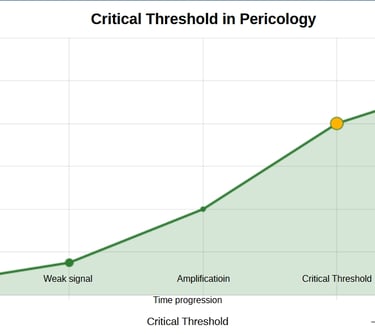
Critical Threshold
Critical threshold diagram
Pericological Example
Context : In an interconnected factory using IoT sensors to monitor production, a progressive overload of machines (weak signal : 10% increase in energy consumption) threatens a cascading failure affecting the regional supply chain.
Pericological Application : A pericologist, using the Cyclosynpraxy approach, detects this weak signal using bio-inspired modeling (e.g., redistribution of flows in a forest ecosystem). Before the critical threshold is reached (total failure of the machines), he proposes a dynamic reallocation of tasks between machines, reducing the load by 15% and stabilizing the system. This preventive action, guided by the analysis of positive loops, avoids a logistics crisis
Etymology
Threshold : From the Latin sulium (or solum , base, ground), designating a physical or symbolic limit or border, like the step of a door
Criticism : From the Greek kritikos (from krinein , to judge, to discern), meaning a decisive moment or situation requiring precise judgment.
Pericological Sources
The Tools of Pericology
Pericological Tools
A "Pericological Tool" refers to any practical device, method or process, designed or adapted to anticipate, detect and prevent systemic perils in human, biological or technological contexts, drawing inspiration from the cooperative dynamics of nature. Anchored in the pillars of Pericology (observation, proactive prevention, contextual adaptation), it translates validated scientific knowledge, notably from bio-inspired collaboration, into applied solutions. These tools are intuitive, accessible and do not presuppose perfect human cooperation, promoting systemic resilience in the face of critical thresholds.
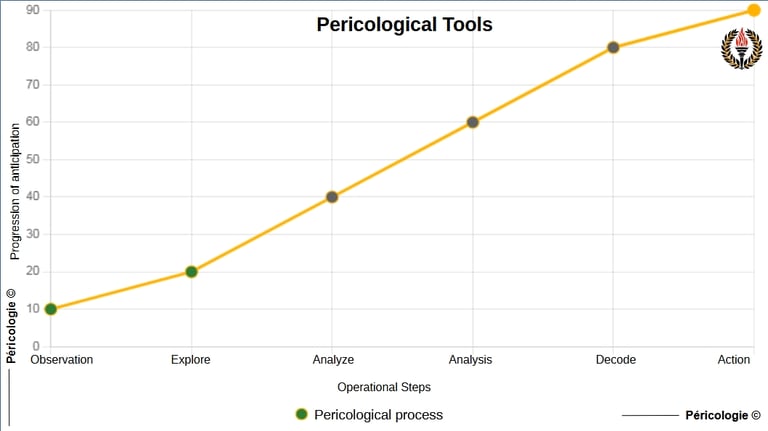

Pericological Tools
Diagram of pericological tools
Pericological Example
Context : A small coastal town faces weak signals of marine erosion (increase in extreme tides, occasional flooding of dikes). Local data (water level sensors) indicate a potential systemic risk, amplified by coastal urbanization (positive loop). Traditional approaches (post-crisis dike reinforcement) are costly and delayed.
Pericological Application : The pericological tool " Bio-Inspired Anticipation Matrix" is deployed. Inspired by coral reefs (redistribution of flows to avoid collapse), this matrix maps measurable signals (tidal height, soil erosion) and models interdependencies (urbanization, marine ecosystem). Step 1 (Explore) : Data collection via IoT sensors. Step 2 (Analyze) : Evaluation of critical thresholds (e.g.: submersion at +1.5 m). Step 3 (Decode) : Identification of a tipping point (dam collapse in 18 months). Action : Implementation of a plant barrier (mangroves) to absorb tides, reducing the danger before the crisis.
Etymology
Tool : From the Latin ūtilis (“useful, functional”), derived from ūtor (“to use, to employ”).
Pericological : Compound of the Latin pēriculum ("danger, risk") and the Greek peri ("around, nearby"), with -logy (from the Greek logos , "speech, study").
Pericological Sources
Ecosynpraxy
The methodological heart of Pericology, "Ecosynpraxy" refers to the bio-inspired approach that translates the cooperative dynamics observed in fauna and flora into practical, intuitive, and scientifically validated tools to anticipate and prevent biological perils. It promotes human collaboration, self-management, and feedback in contexts where communication is limited or rapid decisions are required. Unlike approaches presuming ideal human cooperation, Ecosynpraxy adapts to practical realities, managing biological perils via simple solutions inspired by nature, such as the coordination of fish schools or the resilience of forests. It constitutes the founding basis of Pericology 's bio-inspired identity and depends on Holopraxy for mixed or non-biological perils.
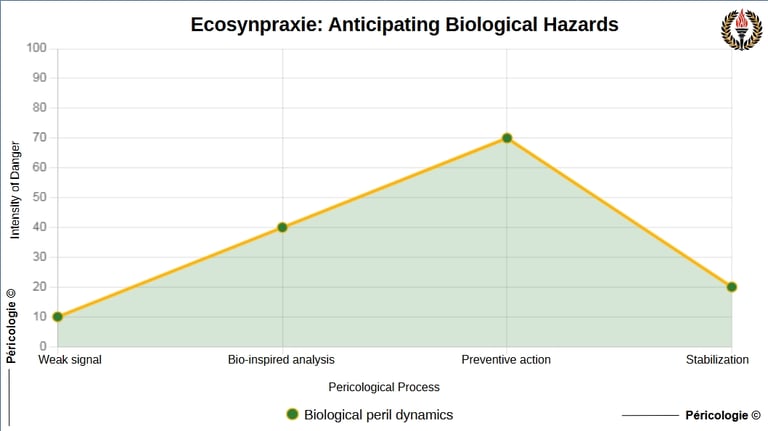

Ecosynpraxy
Ecosynpraxy Diagram
Pericological Example
Context : In an interconnected local agricultural context (e.g., a 50-hectare cooperative farm in a temperate zone, 2025), a biological hazard emerges in the form of an incipient pest infestation (e.g., aphids amplified by a positive loop of accelerated reproduction due to a microbial imbalance). Weak signals include a subtle increase in leaf transpiration (measurable via low-tech sensors) and a 5% reduction in auxiliary biodiversity (e.g., predatory bees). Without anticipation, this reaches a tipping point in 2-3 weeks, threatening 30% of the harvest and the economic balance of the human team (10 farmers). This hazard is purely biological, non-systemic, making Ecosynpraxy ideal as a founding basis, without recourse to Holopraxy for mixed aspects.
Pericological Application : Ecosynpraxytranslates the cooperative dynamics observed in nature (e.g., self-management of ants redistributing pheromones to regulate an invasion) into simple tools for the team. Observation : Detect weak signals via bio-inspired peripheral monitoring (e.g., patrols mimicking animal sentinels). Analysis : Evaluate the positive loop (pest amplification) and identify the critical threshold (density > 10/m²). Action : Apply bio-inspired feedback, such as introducing companion plants (e.g., marigold to attract natural predators), blocking the danger without chemical pesticides.
Etymology
Derived from the Greek oikos ("house", "environment", by extension "ecosystem"), syn ("together", "with") and praxis ("action", "practice").
Pericological Sources
Holopraxy
Holopraxy is a central branch of Pericology, adopting a holistic and interdisciplinary approach to anticipate and manage complex non- biological perils, such as socio-economic, technological or systemic crises. It integrates biological, human, technological and systemic dynamics, unifying complementary paradigms (Sociosynpraxy , Technosynpraxy, Cyclosynpraxy) to address interconnected threats. As the central pivot of the discipline, Holopraxy incorporates Ecosynpraxy for the biological aspects of mixed perils, relying on scientific rigor and practical feasibility. It promotes adapted solutions, anticipating tipping points to prevent crisis escalation.
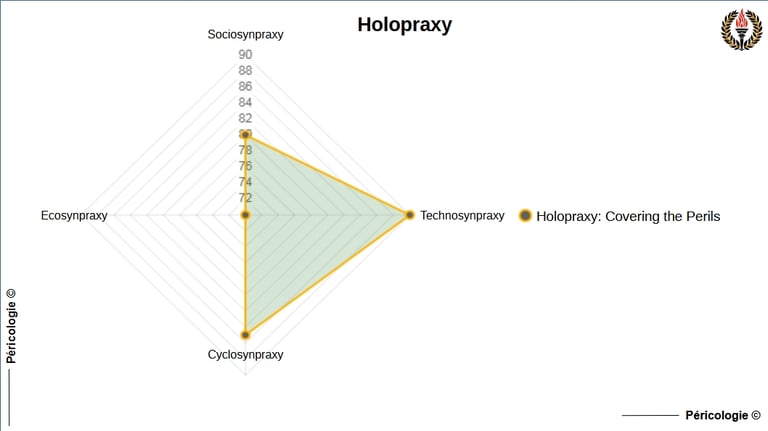

Holopraxy
Holopraxy diagram
Pericological Example
Context : In an interconnected metropolis in 2026, a smart logistics platform (powered by AI) manages urban food flows. Weak signals (recurring delivery delays and increases in energy consumption) indicate a risk of systemic failure, which could lead to supply disruptions and social tensions.
Pericological Application : Holopraxymobilizes an interdisciplinary approach to anticipate this non-biological peril. It integrates : Observation : Analysis of IoT data (measurable signals) and human feedback (weak signals from delivery people). Bio-inspired analysis : Modeling inspired by ecosystems (e.g.: redistribution of flows in an ant colony) to identify a potential tipping point (server overload). Proactive action : Deployment of a multi-agentic algorithm to rebalance flows before the crisis, avoiding disruption.
Etymology
Derived from the Greek holos ("whole", "all") and praxis ("action", "practice"), the term Holopraxy literally means "global action" or "integral practice".
Pericological Sources
Sociosynpraxy
"Sociosynpraxy" is a sub-branch of Pericology, which applies bio-inspired cooperative dynamics to socio-cultural perils. It mobilizes the principles of collaboration, self-management and feedback, drawn from observations of fauna and flora, to anticipate and prevent dysfunctions in human social systems, such as cultural conflicts, polarizations or crises of community cohesion. Pragmatic and anchored in validated scientific bases, it does not presuppose ideal human cooperation, but adapts to contextual realities, favoring rapid and intuitive solutions to preserve social balance.
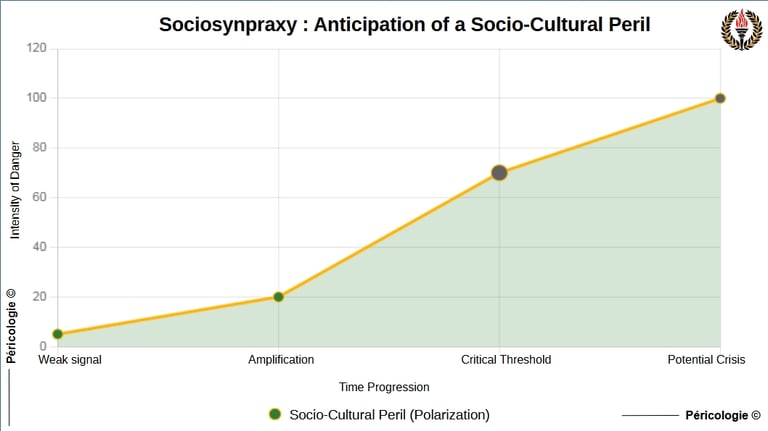

Sociosynpraxy
Sociosynpraxy diagram
Pericological Example
Context : In an urban community of 5,000 inhabitants, socio-cultural tensions are emerging around unequal access to educational resources (e.g., overcrowded schools in some neighborhoods). Weak signals include an increase in complaints on social media and a decrease in participation in community meetings, indicating a risk of polarization (socio-cultural peril). Without intervention, these tensions could reach a tipping point, leading to open conflict or social fracture.
Pericological Application : Sociosynpraxy, a sub-branch of Ecosynpraxia and Holopraxy, applies a bio-inspired approach drawn from the dynamics of cooperation in animal colonies (e.g., ants redistributing resources via decentralized communication). A pericologist observes weak signals (complaints, disengagement), analyzes their severity (risk of polarization), and proposes a proactive action : organizing local participatory workshops, inspired by self-management mechanisms, to equitably redistribute access to educational resources (e.g., community tutoring programs).
Etymology
Socio- : From the Latin socius ("companion, associate"), designating human social interactions and structures.
Syn- : From the Greek sun ("with, together"), emphasizing collective cooperation.
Praxia : From the Greek praxis ("action, practice"), indicating a concrete and methodical application.
Pericological Sources
Technosynpraxy
"Technosynpraxy" is a sub-branch of Holopraxy, within Pericology, which focuses on the anticipation and prevention of complex technological perils affecting interconnected systems. It mobilizes interdisciplinary dynamics (technological, human and systemic) to detect warning signals, analyze critical thresholds and act proactively to counter emerging dysfunctions or crises in technological infrastructures. Inspired by the bio-inspired principles of Pericology, it adapts cooperation and feedback mechanisms observed in nature (such as the self-regulation of ecosystems) to design practical and contextual solutions, without presupposing absolute technological reliability. It relies on scientific rigor and active monitoring to anticipate technological tipping points, promoting systemic resilience.
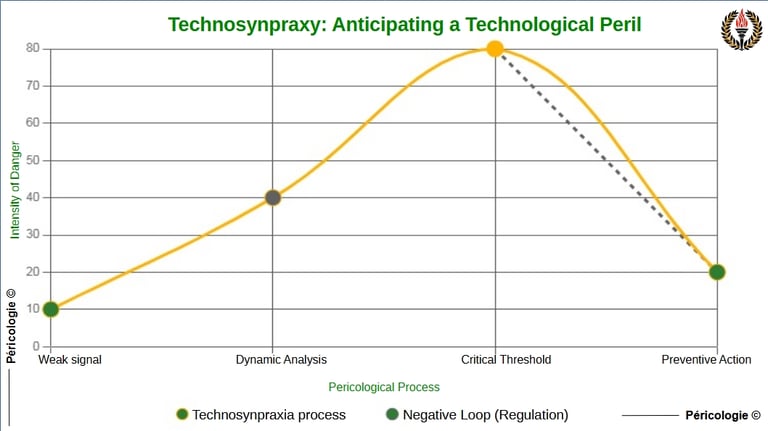

Technosynpraxy
Diagram of technosynpraxy
Pericological Example
Context : In an automated factory using interconnected AI systems for production management, a weak signal is detected : unexplained micro-latencies in machine-to-machine communications. This signal, ignored by standard maintenance protocols, indicates a potential tipping point towards a systemic failure (e.g., production shutdown or amplified cyberattack).
Pericological Application : Technosynpraxyintervenes in three stages : Observation : Identify micro-latencies as weak signals via bio-inspired monitoring, imitating the detection of anomalies in an ecosystem (e.g.: ants spotting an intruder). Analysis : Model the dynamics of latencies as a positive loop (amplification of delays), by crossing machine data with human metrics (operator feedback). Action : Implement a bio-inspired solution, such as a decentralized redistribution of tasks (inspired by swarms), by dynamically reallocating data flows to avoid overload, blocking the danger before the crisis.
Etymology
Techno- : Derived from the Greek tekhnē (τέχνη), meaning "art", "technique" or "know-how", referring to technological systems and tools.
-syn- : From the Greek sun (σύν), meaning "with" or "together", emphasizing the collaborative and interconnected approach.
-praxy : From the Greek praxis (πρᾶξις), meaning "action" or "practice", emphasizing concrete and methodical application.
Pericological Sources
Cyclosynpraxia
A sub-branch of Holopraxy in Pericology, "Cyclosynpraxy" refers to the interdisciplinary and bio-inspired approach dedicated to the anticipation and prevention of systemic perils, that is, emerging threats arising from the complex interconnection between human, technological, biological and environmental systems. It draws on the regulatory dynamics observed in natural ecosystems to model and counter systemic tipping points before they trigger global crises. Cyclosynpraxy is distinguished by its ability to analyze complex interdependencies and propose methodical preventive actions, without presupposing an inherent stability of the systems.

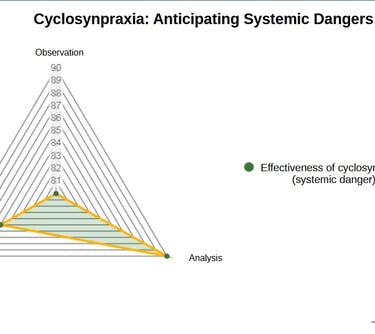
Cyclosynpraxia
Diagram of cyclosynpraxia
Pericological Example
Context : In an interconnected metropolis, a food delivery logistics network relies on IoT sensors, autonomous vehicles, and distribution centers. A weak signal (repeated delays at a logistics node) is detected, risking a cascading supply disruption (systemic tipping point) affecting food security.
Pericological Application : Cyclosynpraxyapplies a bio-inspired approach, inspired by anthills where the redistribution of tasks avoids congestion. Observation identifies the weak signal via the analysis of IoT data (abnormal delays). Analysis models the interconnection of logistics nodes, revealing a risk of positive loop (amplification of delays). Action proposes a dynamic redistribution of deliveries to secondary nodes, adjusted in real time, to stabilize the network (negative loop).
Etymology
Derived from the Greek kuklos ("cycle", "circle"), sun ("together", "with") and praxis ("action", "practice").
Pericological Sources
Bio-Inspired Aspects of Pericology
Pericological Ecosystem
In the context of Pericology, an "ecosystem" refers to a dynamic set of interactions between living (human, animal, plant) and non-living (technological, environmental) entities within a given context, serving as a source of inspiration to anticipate and prevent systemic perils. It is not only a classical ecological concept, but a bio-inspired model of cooperation, self-management and feedback, applied to interconnected human, biological or technological systems. The ecosystem, in Pericology, is an observation matrix to detect warning signals of perils and design pragmatic preventive solutions, anchored in the collaborative dynamics of nature. It embodies the human/peril interconnection, where each component influences the overall balance, requiring peripheral vigilance to block dangers before their tipping point.
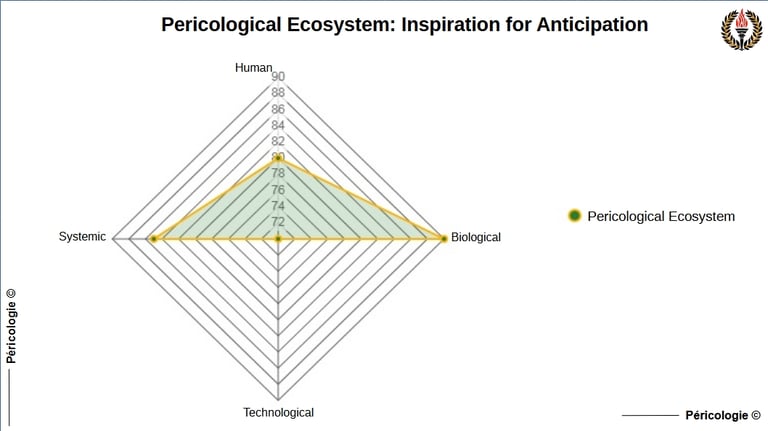

Pericological Ecosystem
Diagram of the pericological ecosystem
Pericological Example
Background : In an automated factory, a network of interconnected machines (sensors, robots, AI systems) forms a technological ecosystem. A weak signal (a sensor overheating) indicates a risk of cascading failure, threatening production.
Pericological Application : Inspired by the regulation of a forest ecosystem (where trees redistribute water to avoid water stress), Pericology applies a negative loop : an observer (monitoring system) detects overheating, an analyzer (algorithm) evaluates its potential impact, and an action (redistribution of the load to other machines) is implemented to prevent the breakdown. This avoids a tipping point (total shutdown) and maintains the balance of the system.
Etymology
The term ecosystem comes from the Greek oikos ("house", "habitat") and systēma ("organized whole", derived from syn- "with" and hístēmi "to place"). Appearing in 1935 in the work of Arthur Tansley, it initially referred to the interactions between organisms and their environment.
Pericological : From the Latin periculum ("danger, risk") and the Greek peri ("around").
Pericological Sources
https://youmatter.world/fr/definition/ecosysteme-definition-enjeux/
https://www.futura-sciences.com/planete/definitions/zoologie-pelagique-2367/
https://fr.wikipedia.org/wiki/Approche_%C3%A9cosyst%C3%A9mique
https://www.dictionnaire-environnement.com/ecosysteme_pelagique_ID4648.html
https://vitrinelinguistique.oqlf.gouv.qc.ca/fiche-gdt/fiche/8401121/ecosysteme
Human/Peril Interconnection
The "Human/Peril Interconnection" refers to the dynamic and reciprocal relationship between human actions, behaviors or decisions and systemic perils (biological, socio-cultural, technological or systemic). In Pericology, this concept emphasizes that humans are neither mere victims nor sole triggers of perils, but interconnected actors in feedback loops (positive or negative) that amplify or mitigate peril dynamics. It is inspired by the cooperative balances of natural ecosystems, where each element influences and is influenced by its environment. The Human/Peril Interconnection requires peripheral observation to detect weak signals and proactive action to prevent tipping points.
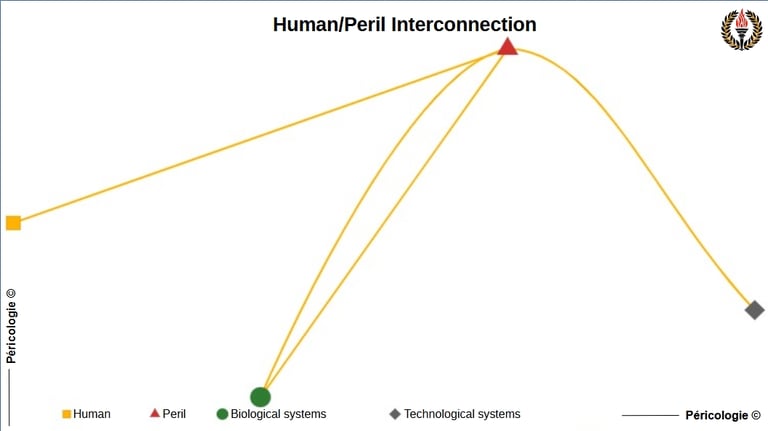

Human/Peril Interconnection
Human/Peril Interconnection Diagram
Pericological Example
Context : In a coastal farming community, weak signals (e.g., increased soil erosion, observed via local sensors) indicate an emerging peril linked to the interconnection between human activity (intensive overcropping) and an environmental imbalance (rising salt waters). Farmers, dependent on these lands, unwittingly amplify the peril through their practices, creating a positive loop (mutual aggravation of human-environmental factors).
Pericological Application : Drawing inspiration from bio-inspired dynamics (e.g., regulation of mangroves through resource redistribution), Pericology mobilizes Ecosynpraxie to observe (sensors measuring erosion), analyze (modeling of crop-saltwater interactions) and act (introduce salt-resistant crops and raise awareness among farmers about self-management). This breaks the positive loop, stabilizing the system before the tipping point (agricultural collapse).
Etymology
Interconnection : From the Latin inter ("between") and connexio ("link, relationship"), meaning a reciprocal relationship between elements.
Human : From the Latin humanus ("that which is proper to man"), here encompassing collective actions, decisions and impacts.
Peril : From the Latin periculum ("danger, ordeal"), central to Pericology to designate an emerging or established systemic threat.
Pericological Sources
https://en.wikipedia.org/wiki/Existential_risk_from_artificial_intelligence
https://www.sciencedirect.com/science/article/abs/pii/S001632871930357X
https://futureoflife.org/data/documents/Existential%20Risk%20Resources%20%282015-08-24%29.pdf
https://link.springer.com/article/10.1007/s11098-025-02301-3
https://link.springer.com/rwe/10.1007/978-3-319-31737-3_45-1
The Perils of Pericology
Dynamics of Perils
"Peril Dynamics" refers to the interconnected evolutions, causes and factors that shape the emergence, amplification or mitigation of perils in complex systems (human, biological, technological or systemic). In Pericology, these dynamics are observed and analyzed to identify warning signals (weak or measurable) and anticipate critical thresholds before a peril turns into a crisis. Inspired by the cooperative dynamics of nature, they are modeled to understand systemic interactions and propose preventive actions adapted to local contexts.
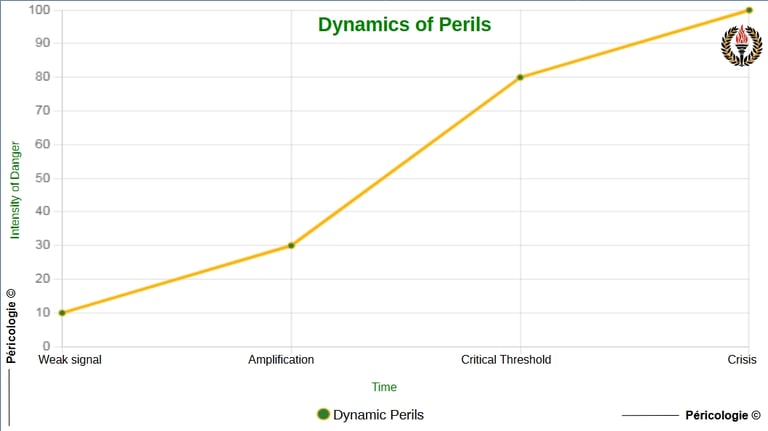

Dynamics of Perils
Diagram of the dynamics of perils
Pericological Example
Context : A regional food supply chain dependent on a single grain supplier experiences recurring weather disruptions (e.g., local droughts). Delivery delays amplify stock pressures, threatening food security (diffuse peril).
Pericological Application : Inspired by the dynamics of ecosystem regulation (e.g., redistribution of resources in an ant colony), a pericologist observes weak signals (e.g., 10% drop in deliveries over 3 months). He analyzes the dynamics : a positive loop where delays increase local speculation, risking a tipping point (shortage). The proposed action is a proactive diversification of supply sources via local partnerships, stabilizing the system (negative loop).
Etymology
Dynamics : From the Greek dynamis ("force, power"), designating the movement or active evolution of a system, here applied to the evolutionary processes of perils.
Perils : From the Latin periculum ("danger, risk"), anchoring the idea of a potential threat to a balance, observed peripherally.
Pericological Sources
https://journals.openedition.org/communicationorganisation/4494
https://www.sator.fr/cours/risques-systemiques-et-strategies-de-resilience
https://www.ihemi.fr/articles/risques-systemiques-globaux-risques-effondrement
https://www.carbone4.com/publication-strategie-analyse-par-scenario
https://www.cairn.info/le-management-des-risques-et-des-crises--9782100567317-page-65.htm
https://shs.cairn.info/revue-economique-2015-3-page-481?lang=fr
Systemic Peril
A "Systemic Peril" refers to a complex and interconnected threat affecting a system as a whole, whether human, biological, technological or socio-economic. It is characterized by amplifying dynamics (positive loops) or tipping points that can destabilize the overall balance, leading to crises that are difficult to contain. In Pericology, the peripheral anticipation of systemic perils is based on the early detection of weak and measurable signals, allowing proactive prevention before critical thresholds are reached.
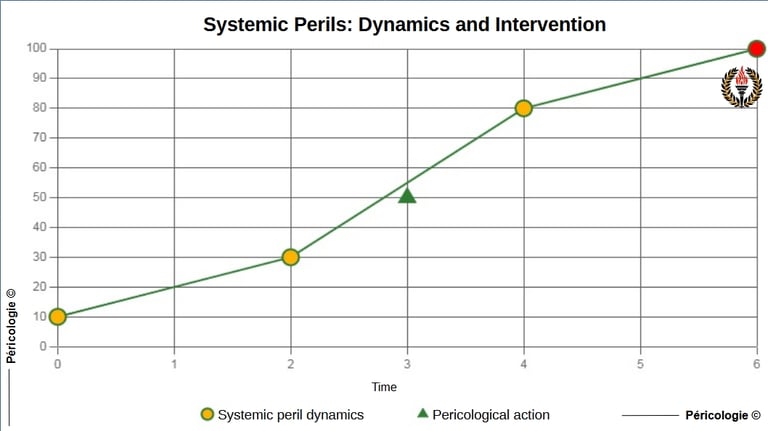

Systemic Peril
Systemic Peril Diagram
Pericological Example
Context : In a smart city in 2025, an interconnected AI network manages energy supply, transportation, and telecommunications. A weak signal (temporary overload in an energy node) is detected, risking a cascading failure affecting dependent systems (transport stopped, hospitals under strain).
Pericological Application : A pericologist, via Cyclosynpraxy, observes this signal (Observation), analyzes the interdependencies of the network to identify a potential tipping point (Analyze), and proposes an automatic redistribution of energy flows, inspired by the regulatory mechanisms of ecosystems (e.g.: anthills reallocating resources). This proactive action (Act) stabilizes the network, preventing a systemic crisis.
Etymology
Peril : From the Latin periculum (“danger, risk”), derived from periri (“to experience, to attempt”), connoting an imminent threat to balance.
Systemic : From the Greek sustēma (“organized whole”), composed of sun- (“with”) and histanai (“to establish”), referring to an interdependent whole.
Pericological Sources
https://fr.wikipedia.org/wiki/Risque_financier_syst%C3%A9mique
https://www.capital.fr/entreprises-marches/risque-systemique-1382342
https://dictionnaire.lerobert.com/en/definition/risque-systemique
https://geoconfluences.ens-lyon.fr/glossaire/systemes-theorie-des-et-risques-systemiques
https://www.techno-science.net/glossaire-definition/Systemique.html
https://www.epsilonmelia.com/ressources-pedagogiques/approche-systemique-therapeutique-definition/
Emerging Peril
An "Emerging Peril" refers, in the context of Pericology, to an emerging or developing threat, identifiable by weak or early signals, but not yet having reached a critical threshold or tipping point. Unlike established perils, these dangers are often not very visible, as they evolve in complex and interconnected dynamics, whether biological, human, technological or systemic. Pericology emphasizes their early detection through peripheral observation and methodical analysis, in order to enable proactive prevention before their amplification. This concept is part of the pillar of peripheral anticipation and relies on bio-inspired dynamics to model emerging risks.
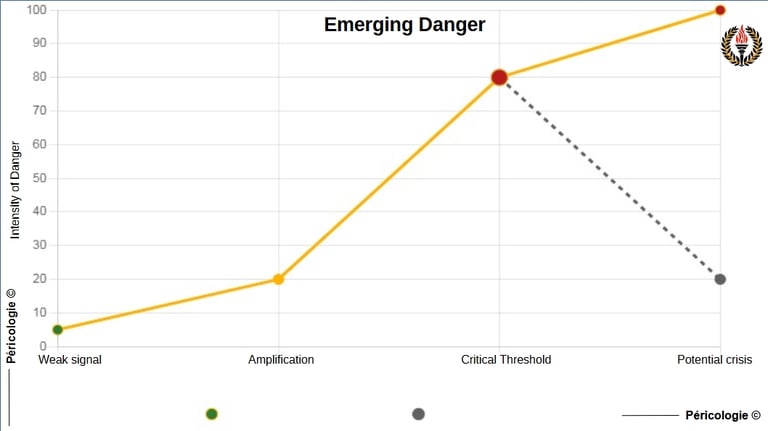

Emerging Peril
Emerging Peril Diagram
Pericological Example
Context : In a connected city dependent on an IoT network to manage street lighting and traffic, weak signals (intermittent latencies in sensors) indicate an emerging vulnerability related to a potential cyberattack. This peril, not yet evident, threatens to disrupt the urban infrastructure (e.g., cascading outages of traffic lights).
Pericological Application : Pericology, via the Cyclosynpraxy approach, observes these weak signals (measured latencies) and analyzes their dynamics (positive loop : amplification by network overload). Inspired by bio-inspired regulation (e.g.: redistribution of flows in an ant colony), it proposes a proactive action: deploying a software micro-correction to balance the loads before the tipping point.
Etymology
Peril : From the Latin periculum , meaning "danger" or "risk", derived from periri ("to test, to tempt"), evoking a potential threat to a balance.
Emerging : From the Latin emergere , composed of e- ("out of") and mergere ("to plunge"), meaning "to come out, to appear".
Pericological Sources
Invisible Peril
An "Invisible Peril" refers, in Pericology, to a systemic threat that escapes immediate detection due to the absence of obvious or measurable signals in the short term. These perils, often diffuse or emerging, manifest themselves through subtle dynamics. Their invisibility stems from a lack of recognition by local actors or an inability of traditional systems to identify them before they reach a tipping point. Pericology, through its peripheral anticipation approach, mobilizes methodical observation and analysis of weak signals to make them visible and counterable, drawing inspiration from natural dynamics where species detect imperceptible threats.
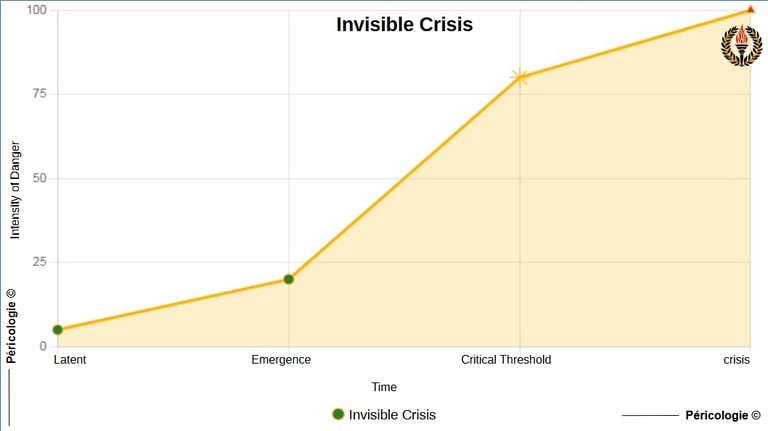

Invisible Peril
Diagram of the invisible peril
Pericological Example
Context : In a small farming community dependent on an automated irrigation system, a slow degradation of moisture sensors goes unnoticed, as yields remain stable in the short term. This invisible peril, undetected by usual indicators (e.g., crop production), risks causing a sudden breakdown of the system, threatening crops (tipping point).
Pericological Application : By applying Ecosynpraxy, Pericology draws inspiration from ants detecting environmental stresses via subtle chemical signals. A pericologist deploys bio-inspired sensors to monitor micro-variations in the performance of irrigation sensors (weak signals). Analysis reveals abnormal wear, and proactive action (targeted maintenance) is implemented, avoiding a systemic crisis. This example illustrates peripheral anticipation, detecting peril before it becomes visible.
Etymology
Peril : From the Latin periculum (“danger, risk”), derived from periri (“to experience, to tempt”), evoking a potential threat to a balance.
Invisible : From the Latin invisibilis (“which cannot be seen”), from in- (“not”) and visibilis (“visible”, from videre , “to see”).
Pericological Sources
https://www.hcn.org/issues/51-11/editors-why-invisible-dangers-are-the-hardest-to-face/
https://www.ayesa.com/en/insight/the-invisible-danger-how-data-poisoning-can-turn-ai-into-a-threat/
https://medium.com/invisible-illness/the-invisible-dangers-764a0171aec7
https://tractortoolsdirect.com/blog/ticks-a-nearly-invisible-danger-for-farmers/
Diffuse Peril
A "Diffuse Peril", in the context of Pericology, refers to a systemic threat characterized by dispersed, fragmented effects or those that are difficult to attribute to a single cause, making its identification and prevention complex. Unlike localized or obvious perils, these dangers manifest themselves through weak signals, often diluted in interconnected dynamics (human, biological or technological), and escape conventional detection approaches. Pericology proposes to anticipate them through peripheral observation, drawing inspiration from the cooperative dynamics of nature to identify their subtle interactions before they reach a tipping point.
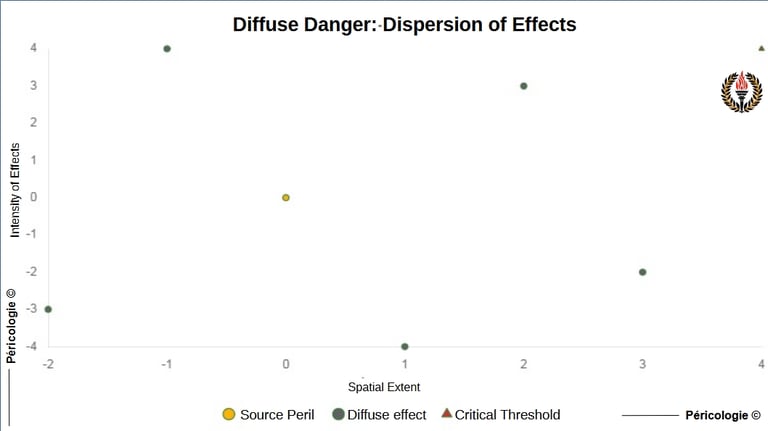

Diffuse Peril
Diffuse Peril Diagram
Pericological Example
Context : In a small town dependent on a social network for local news, fragmented rumors of a food shortage emerge, amplified by anonymous posts. These diffuse signals, shared across platforms, create a gradual panic with no immediately identifiable cause (e.g., no confirmed logistics crisis). This diffuse peril threatens social cohesion and local economic balance.
Pericological Application : A pericologist, acting as an observer, detects weak signals (increase in alarmist posts on X, analyzed via active monitoring). Inspired by the dynamics of fish school regulation (negative loop to avoid amplification), he analyzes the sources of rumors via a mapping of digital interactions. To act, he recommends a transparent communication campaign by local authorities, disseminating verified data (e.g.: real food stocks) to counter the amplification of the peril before a tipping point (e.g.: widespread panic).
Etymology
Peril : From the Latin periculum , meaning "danger", "risk" or "ordeal", implying a potential threat to a balance.
Diffuse : From the Latin diffusus , past participle of diffundere ("to spread", "to disperse"), formed from dis- ("apart", "in multiple directions") and fundere ("to pour", "to spread").
Pericological Sources
The Signals of Pericology
Warning Signal
In the context of Pericology, a "Warning Signal" refers to an early, often discreet but detectable, indication of the potential emergence of a systemic peril, whether biological, socio-cultural, technological or systemic. This signal, observable via bio-inspired methods or analytical tools, makes it possible to anticipate an imbalance before it reaches a critical threshold or a tipping point. Unlike obvious signals, it requires peripheral vigilance to be detected, mobilizing the pillars of Pericology : proactive observation, methodical analysis and preventive action. Example of application : a slight increase in interpersonal conflicts in a team can signal a danger of collective disorganization, detectable by behavioral indicators. Inspired by natural dynamics, Pericology translates these clues into concrete actions to block the peril.
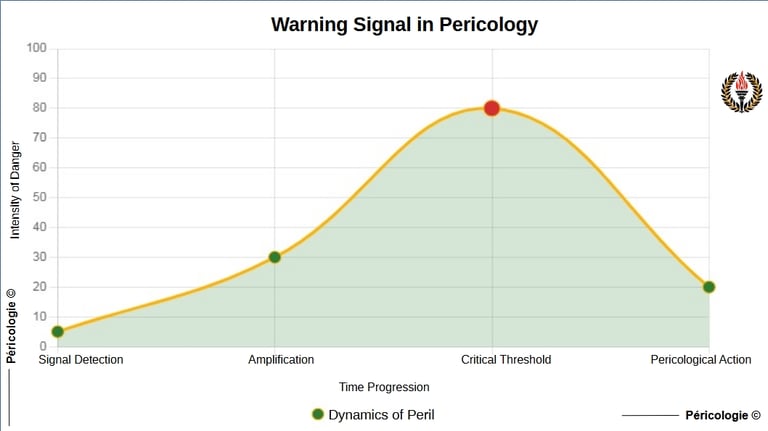

Warning Signal
Warning signal diagram
Pericological Example
Context : In a city dependent on a logistics network for food distribution, repeated but minor delays in fresh produce deliveries (e.g., 10-15 minutes over several days) are observed in a specific neighborhood. These delays, discreet and not yet critical, constitute a warning signal of a potential systemic peril : a supply disruption due to an overloaded road network or a technological failure (e.g., malfunctioning traffic management systems).
Pericological Application : A pericologist, applying the Pericology methodology (Explore, Analyze, Decode), uses bio-inspired observation(inspired by ants adjusting their routes in the face of obstacles) to detect this weak signal. He analyzes traffic data and identifies an abnormal increase in travel time (measurable signal). By acting proactively, he proposes an adjustment of the routes via a flow distribution algorithm, avoiding a tipping point (e.g.: total disruption of deliveries).
Etymology
Signal : From the Latin signum ("sign, mark"), designating an indicator or an observable manifestation of a phenomenon.
Forerunner : Derived from the French avant (Latin ab ante , "in front of") and coureur (Latin currere , "to run"), literally "that which runs in front of", i.e. a precursor announcing an event.
Pericological Sources
Weak Peripheral Signal
A "Weak Peripheral Signal" refers, in Pericology, to a subtle indicator, often difficult to detect without increased vigilance, which announces the potential emergence of a systemic peril at the periphery of a system (human, biological, technological or interconnected). These signals, although discreet, are measurable and carry critical information on emerging risk dynamics, before they reach a critical threshold or a tipping point. They are distinguished from warning signals by their less obvious nature and from measurable signals by their low amplitude, requiring methodical and bio-inspired observation. The weak peripheral signal is central to proactive anticipation, allowing us to "see before" in order to "block before", in accordance with the slogan of Pericology.
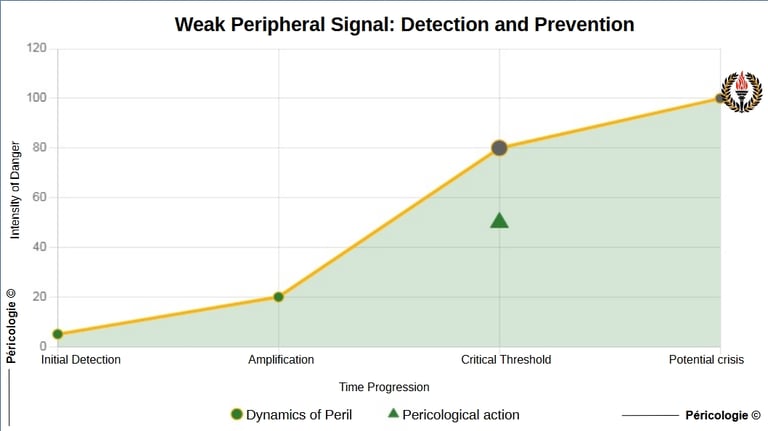

Weak Peripheral Signal
Weak Peripheral Signal Diagram
Pericological Example
Context : In an interconnected automated factory, micro-variations in the energy consumption of machines (e.g. +2% on a unit) go unnoticed by standard control systems, because they are below the classic alert thresholds.
Pericological Application : A pericologist, acting as an observer, uses a bio-inspired approach (predator detection model in a bird colony) to identify these micro-variations as a weak peripheral signal. By analyzing the data via Ecosynpraxia, he models a potential cascading overheating (tipping point). A proactive action is proposed: dynamically adjust the load of the machines to stabilize the system, avoiding a systemic failure.
Etymology
Signal : From the Latin signum ("sign, mark"), designating an observable indication referring to information or an event to be interpreted.
Peripheral : Derived from the Greek peri ("around") and pherein ("to carry"), meaning that which surrounds or frames a central system.
Weak : From the Latin flebilis ("worthy of being mourned", then "fragile, weak"), indicating a reduced intensity, difficult to perceive without methodical attention.
Pericological Sources
Measurable Signal
In the context of Pericology, the "Measurable Signal" refers to the concrete, quantifiable and observable indicator that reveals the presence or evolution of a systemic peril before it reaches a critical threshold. This signal, resulting from biological, human or technological dynamics, is detected by rigorous observation tools (sensors, statistical analyses, or contextual data) and translated into exploitable data to anticipate and counter the perils. Unlike the weak signal, which remains subtle and qualitative, measurable signals offer an objective basis for analysis and proactive action.
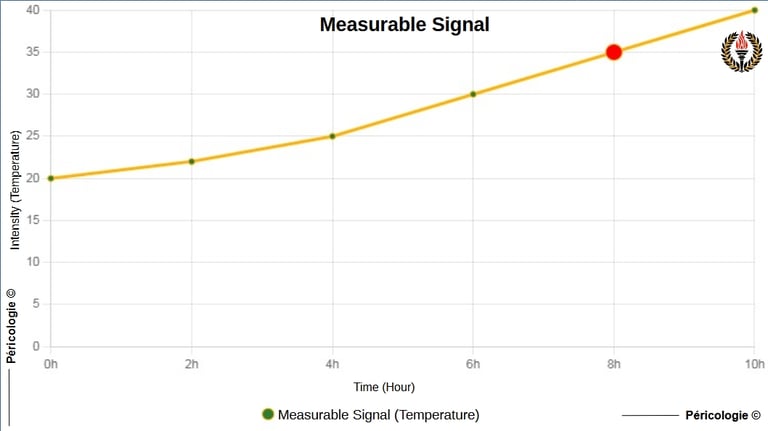

Measurable Signal
Measurable signal diagram
Pericological Example
Context : In a small coastal town, a water treatment plant is interconnected to a network of environmental sensors monitoring water quality (pH, turbidity, pollutants). An emerging peril, such as diffuse contamination by microplastics, threatens the local ecological balance, with a risk of a tipping point (e.g., collapse of aquatic fauna). Pericology intervenes to anticipate this peril before it becomes a crisis.
Pericological Application : A measurable signal, such as the constant increase in the rate of microplastics (quantified at 0.2 mg/L over 7 days via sensors), is detected by the Pericological Observer. Inspired by bio-inspired dynamics (e.g.: regulation of coral reefs in the face of toxins), the pericological team analyzes this signal (Analyze) to assess its potential impact (e.g.: cumulative toxicity). A proactive action is implemented (Act): adjustment of the factory filters to reduce microplastics before the critical threshold (0.5 mg/L).
Etymology
Signal : From the Latin signum ("sign, mark"), designating an index or a perceptible manifestation of a phenomenon.
Measurable : Derived from the Latin mensura ("measure") and the verb metiri ("to measure").
Pericological Sources
https://www.sciencedirect.com/science/article/abs/pii/S0957582021006364
https://epjdatascience.springeropen.com/articles/10.1140/epjds/s13688-024-00457-2
https://www.openriskmanual.org/wiki/Early_Warning_Indicators
https://en.wikipedia.org/wiki/Strategic_early_warning_system
https://www.researchgate.net/publication/318661569_WEAK_SIGNALS%27_STATUS_IN_THE_RISK_MANAGEMENT
https://www.sciencedirect.com/science/article/abs/pii/0024630184900347
https://www.sciencedirect.com/science/article/abs/pii/S0016328711002576
For enthusiasts
Our links
Message
© 2025. All rights reserved. By Pericology
